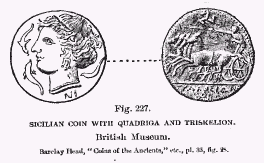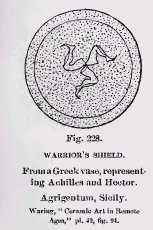

The Swastika
Dispersion of the Swastika
Perrot and Chipiez, (1) speaking of Lycia, say:
The device of many of her coins is the "triskelis" or so called "triquetra"
 (literally,
three-cornered, triangular), a name derived from three serpents' heads,
which usually figure in the field, much after the fashion of those supporting
the famous tripod at Delphi, (2)
consecrated by the Greeks to Apollo after the battle of Platæa.
The number of heads is not constant, some coins having as many as four,
"tetraskelis," whole others have but two, "diskelis."
(3)
(literally,
three-cornered, triangular), a name derived from three serpents' heads,
which usually figure in the field, much after the fashion of those supporting
the famous tripod at Delphi, (2)
consecrated by the Greeks to Apollo after the battle of Platæa.
The number of heads is not constant, some coins having as many as four,
"tetraskelis," whole others have but two, "diskelis."
(3)The Greeks connected the symbol with the cult of Apollo, which they represented as very popular and of hoary antiquity in Lycia. The three-rayed design appears to have gained the victory over the others, and came into commoner use. It is found on Assyrian coins, and also as a countermark on coins of Alexander, B. C. 333 to 323. A comparison of these designs with the Swastika will, it is believed, show their dissimilarity, and the non-existence of relationship. In the Lycian designs, whether with two, three, or four rays, there is a central hub out of which the spokes spring. In the center of the hub is the small circle and dot which might represent the axle on which the machine revolved. In fact, the Lycian design is a fir representation of the modern screw propeller, and gives the idea of a whirling motion.
 Compare these peculiarities with the Swastika. The Swastika is almost
always square, is always a cross at right angles or near it, and whatever
may become of the ends or arms of the cross, whether they be left straight,
bent at right angles, or in a curve, it still gives the idea of a cross.
There is no center except such as is made by the crossing of the two arms.
There is not, as in these triskelions, a central hub. There is no dot
or point around which the design or machine could be made to revolve,
as in these Lycian triskelions; nothing of the central boss, cup, or nave,
which forms what the Germans call the "Rad-Kruez,:P wheel cross,
as distinguished from the square cross.
Compare these peculiarities with the Swastika. The Swastika is almost
always square, is always a cross at right angles or near it, and whatever
may become of the ends or arms of the cross, whether they be left straight,
bent at right angles, or in a curve, it still gives the idea of a cross.
There is no center except such as is made by the crossing of the two arms.
There is not, as in these triskelions, a central hub. There is no dot
or point around which the design or machine could be made to revolve,
as in these Lycian triskelions; nothing of the central boss, cup, or nave,
which forms what the Germans call the "Rad-Kruez,:P wheel cross,
as distinguished from the square cross. In this regard Greg says:
If R. Brown's lunar and Semitic or Asiatic origin of the Triquetra, however, should be established, then the entire argument of the triquetra being derived form the fylfot, or vice versa, falls to the ground. * * * That the device arose out of the triskele and triquetra I do not think can be proved. It is clear the
Waring, explaining the tetraskelion (four-armed), declares it to have preceded the triskelion (three-armed), and he explains its meaning, (4) citing Sir Charles Fellows, as being a harpago, a grappling iron, a canting sign for Harpagus, who conquered Lycia for Cyrus, circa, 564 B. C.
This, with the statement of Perrot and Chipiez (p. 872 of this paper), is a step in explanation of the adoption of the triskelion, and together they suggest strongly that it had no relation on the Lycian coins to the Swastika. At the date of the appearance of the triskelion on the Lycian coins the Swastika was well known throughout the Trojan peninsula and the Ægean Sea, and the difference between them was so well recognized that one could not possibly have been mistaken for the other.
Triskelion, Sicily. --- Now we pass to the consideration of the triskelion of Sicily. Fig. 227 represents a coin of Sicily. On the obverse the head of Persephone, on the reverse the quadriga, and above, the triskelion. Other specimens of the same kind, bearing the same triskelion, are seen in Barclay Head's work on the "Coinage of Syracuse." And his "Guide to the Ancient Coins in the British Museum." They belong to the early part of the reign of Agathocles, B. C. 317 to 310. In these specimens the triskelion is quite small; but as the coins belong to the period of the finest engraving and die-sinking of Greece, the representation , however minute, is capable of decipherment. Fig. 228 is taken from the shield of a warrior on a Greek vase representing Achilles and Hector, in which the armorial emblem of Sicily, the triskelion, occupies the entire field, (5) and represents plainly that it is three human legs, conjoined at the thigh, bent sharply at the knee, with the foot and toes turned out. Some of these have been represented covered with mail armor and the foot and leg booted and spurred. It is evident that these are human legs, and so were not taken from the screw propeller of Lycia, while they have no possible relation to the crossed arms of the Swastika, and all this despite their similarity of appearance. This is rendered clearer by Waring, (6) where the amorial emblem on a warrior's shield is a single human leg, bent in the same manner, instead of three. Apropos of Swastikas on warrior's shields, reference is made to figs. 257 and 258, which represent two shields of Pima Indians, New Mexico, both of which have been in battle and both have the four-armed Swastika or tetraskelion. There is not in the Swastika, nor was there ever, any central part, any hub, any axis, any revolution. It is asserted that originally the triskelion of Sicily, pos-
ENDNOTES:
1. "History of Art in Phrygia, Lydia, Caria, and Lycia," p. 391. [Back]
2. An unique cast of this tripod is in the U. S. National Museum, Department of Oriental Antiquities. Back
3. The number of heads may have been regulated by the size of the coins in question, probably answering to different values. Back
4. "Ceramic Art in Remote Ages," p. 85. Back
5. "Ceramic Art in Remote Ages," pl. 13, fig. 24. Back
6. Ibid, pl. 13, fig. 21. Back
<< Previous Page Next Page >>
© 2004-2007 Northvegr.
Most of the material on this site is in the public domain. However, many people have worked very hard to bring these texts to you so if you do use the work, we would appreciate it if you could give credit to both the Northvegr site and to the individuals who worked to bring you these texts. A small number of texts are copyrighted and cannot be used without the author's permission. Any text that is copyrighted will have a clear notation of such on the main index page for that text. Inquiries can be sent to info@northvegr.org. Northvegr™ and the Northvegr symbol are trademarks and service marks of the Northvegr Foundation.

|